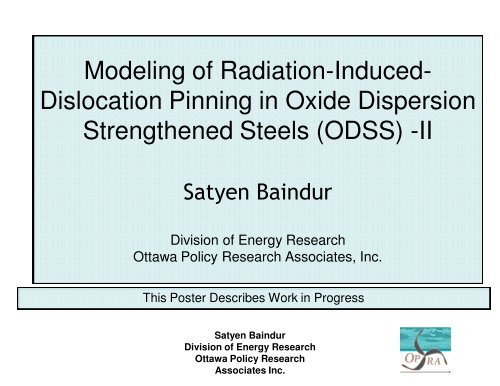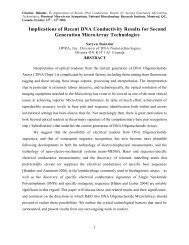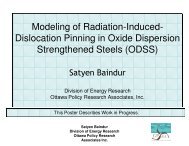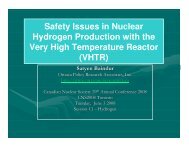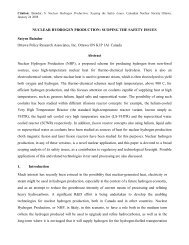Dislocation Pinning in Oxide Dispersion Strengthened Steels
Dislocation Pinning in Oxide Dispersion Strengthened Steels
Dislocation Pinning in Oxide Dispersion Strengthened Steels
Create successful ePaper yourself
Turn your PDF publications into a flip-book with our unique Google optimized e-Paper software.
Model<strong>in</strong>g of Radiation-Induced-<br />
<strong>Dislocation</strong> <strong>P<strong>in</strong>n<strong>in</strong>g</strong> <strong>in</strong> <strong>Oxide</strong> <strong>Dispersion</strong><br />
<strong>Strengthened</strong> <strong>Steels</strong> (ODSS) -II<br />
Satyen Ba<strong>in</strong>dur<br />
Division of Energy Research<br />
Ottawa Policy Research Associates, Inc.<br />
This Poster Describes Work <strong>in</strong> Progress<br />
Satyen Ba<strong>in</strong>dur<br />
Division of Energy Research<br />
Ottawa Policy Research<br />
Associates Inc.
<strong>Oxide</strong> <strong>Dispersion</strong> <strong>Strengthened</strong> <strong>Steels</strong><br />
ODS <strong>Steels</strong> are Made by Ball-mill<strong>in</strong>g<br />
Yttrrium and Titanium <strong>Oxide</strong> Powders<br />
with Ferritic and Austenitic <strong>Steels</strong><br />
<strong>Oxide</strong> dispersion stable above 700 C; but precipitation hardened is not.<br />
Satyen Ba<strong>in</strong>dur<br />
Division of Energy Research<br />
Ottawa Policy Research<br />
Associates Inc.
<strong>Oxide</strong> <strong>Dispersion</strong> <strong>Strengthened</strong> <strong>Steels</strong><br />
Kimura 2007 SMINS<br />
Satyen Ba<strong>in</strong>dur<br />
Division of Energy Research<br />
Ottawa Policy Research<br />
Associates Inc.
<strong>Oxide</strong> <strong>Dispersion</strong> <strong>Strengthened</strong> <strong>Steels</strong><br />
<strong>Dispersion</strong>s are<br />
nanosized (5nm)<br />
while gra<strong>in</strong> size is<br />
about 1 micron<br />
ODS <strong>Steels</strong> are Made by Ball-mill<strong>in</strong>g<br />
Yttrrium and Titanium <strong>Oxide</strong> Powders<br />
Ferritic, Martensitic and Austenitic <strong>Steels</strong><br />
Satyen Ba<strong>in</strong>dur<br />
Division of Energy Research<br />
Ottawa Policy Research<br />
Associates Inc.
<strong>Oxide</strong> <strong>Dispersion</strong> <strong>Strengthened</strong> <strong>Steels</strong><br />
Typical TEM Images of Microstructure and Bubble formation <strong>in</strong> Irradiated ODSS<br />
Akasaka et al 2004 JNM<br />
Satyen Ba<strong>in</strong>dur<br />
Division of Energy Research<br />
Ottawa Policy Research<br />
Associates Inc.
<strong>Oxide</strong> <strong>Dispersion</strong> <strong>Strengthened</strong> <strong>Steels</strong><br />
Egami, Wang, Simonson (Oak<br />
Ridge), 2006.<br />
Satyen Ba<strong>in</strong>dur<br />
Division of Energy Research<br />
Ottawa Policy Research<br />
Associates Inc.
<strong>Oxide</strong> <strong>Dispersion</strong> <strong>Strengthened</strong> <strong>Steels</strong><br />
BUT<br />
Wang<br />
2006<br />
Satyen Ba<strong>in</strong>dur<br />
Division of Energy Research<br />
Ottawa Policy Research<br />
Associates Inc.
Corrosion Behavior of ODS <strong>Steels</strong> with<br />
different dispersoid concentrations under SCW<br />
Satyen Ba<strong>in</strong>dur<br />
Division of Energy Research<br />
Ottawa Policy Research<br />
Associates Inc.<br />
Jang et al 2007
ODS <strong>Steels</strong>: Candidate Structural and<br />
Cladd<strong>in</strong>g Materials for Advanced Reactors<br />
• Questions and Predictive Understand<strong>in</strong>g Required:<br />
• What aspects of the Dispersed Medium (Y, Ti, Cr, Al, etc oxides) are<br />
Responsible for the Excellent Irradiation Creep Strength?<br />
• How does Dispersed Medium <strong>in</strong>teract with the Matrix?<br />
• How does the Cubic Centered Structure of the Matrix provide<br />
Irradiation Swell<strong>in</strong>g Resistance?<br />
• How do the different Dispersed Media <strong>in</strong>teract with each other?<br />
• Can the composition, temperature, and radiation dose dependence<br />
of the behavior be expla<strong>in</strong>ed/predicted?<br />
• How are Radiation-Induced <strong>Dislocation</strong>s P<strong>in</strong>ned?<br />
• How might SCW-ODSS <strong>in</strong>teractions be understood?<br />
Satyen Ba<strong>in</strong>dur<br />
Division of Energy Research<br />
Ottawa Policy Research<br />
Associates Inc.
Multiscale Materials Model<strong>in</strong>g<br />
• The Interaction of Materials with Radiation is an <strong>in</strong>tr<strong>in</strong>sically<br />
Multiscale Phenomenon:<br />
• Atomistic Scale Events Metre Scale Effects<br />
• Picosecond Scale Events Effects at Decade Scale<br />
• Events at all scales must be <strong>in</strong>tegrated <strong>in</strong> a truly predictive Model,<br />
but at the right resolution<br />
• Also: expla<strong>in</strong> events not accessible <strong>in</strong> experiments: either because<br />
of time scale (e.g. 60 year reactor life) or difficult to achieve <strong>in</strong> lab<br />
(e.g. SCW environment + fast spectrum neutron dose or<br />
Furnaces at T > 1300 C or Real-time microscopy)<br />
Satyen Ba<strong>in</strong>dur<br />
Division of Energy Research<br />
Ottawa Policy Research<br />
Associates Inc.
Multiscale Processes dur<strong>in</strong>g Material<br />
Irradiation<br />
Satyen Ba<strong>in</strong>dur<br />
Division of Energy Research<br />
Ottawa Policy Research<br />
Associates Inc.<br />
Wirth 2005
Multiscale Model<strong>in</strong>g<br />
• Could the <strong>Oxide</strong> Particles be s<strong>in</strong>ks for po<strong>in</strong>t defect migration?<br />
• Could the <strong>Oxide</strong> <strong>Dispersion</strong>, as a whole, p<strong>in</strong> dislocations, as a result<br />
of lattice mismatches?<br />
• Could <strong>Oxide</strong> <strong>Dispersion</strong> slow Phase segregation? <strong>Oxide</strong> dispersion<br />
exhibits phase stability under irradiation (Kimura 2007 SMINS)<br />
• Could <strong>Oxide</strong>s of Transition Metals preferentially form higher oxides,<br />
prevent<strong>in</strong>g corrosion? Yttrium-Titanium pyrochlores – Y 2 Ti 2 O 7<br />
formation reported (Kimura 2007 SMINS)<br />
Satyen Ba<strong>in</strong>dur<br />
Division of Energy Research<br />
Ottawa Policy Research<br />
Associates Inc.
Dist<strong>in</strong>ct Levels of Multiscale Model<strong>in</strong>g<br />
• Atomistic: Electrons are the dynamic objects: QM states of<br />
electrons determ<strong>in</strong>es atomic dynamics: QMC, TBA,<br />
DFT, LDA<br />
• Microscopic: Atoms are objects of <strong>in</strong>terest: Interatomic Potentials<br />
mediated by electrons: Molecular Dynamics methods, with Classical<br />
Interatomic Potentials derived from DFT<br />
• Mesoscopic: Gra<strong>in</strong> boundaries, dislocations, are the objects of<br />
<strong>in</strong>terest; dynamics derived from phenomenological potentials based<br />
on microscopic level: <strong>Dislocation</strong> Dynamics - DD<br />
• Macroscopic: Materials behavior described by ‘constitutive<br />
equations’ – volume, temperature, stress and stra<strong>in</strong>, etc become<br />
dynamic variables of <strong>in</strong>terest: F<strong>in</strong>ite Element Model<strong>in</strong>g FE<br />
• Sequential or Concurrent (Kaxiras 2005)<br />
Satyen Ba<strong>in</strong>dur<br />
Division of Energy Research<br />
Ottawa Policy Research<br />
Associates Inc.
<strong>Dislocation</strong> Dynamics<br />
• Peierls-Nabarro (P-N) <strong>Dislocation</strong> Model<br />
– The creation and motion of dislocations mediates the response<br />
of a crystal to external stress.<br />
– The P-N model <strong>in</strong>corporates details of discrete dislocation core<br />
<strong>in</strong>to cont<strong>in</strong>uum framework, and is an <strong>in</strong>herently multiscale model.<br />
– Modified P-N model has been used <strong>in</strong> model<strong>in</strong>g evolution of the<br />
precipitate microstructure (Vaithyanathan et. al. 2002) to yield<br />
phase-field <strong>in</strong>formation.<br />
– Similar model may be applicable for ODSS, which should show<br />
phase stability – though the size distribution of the precipitate<br />
microstructure may be more heterogeneous than <strong>in</strong> ODSS.<br />
Satyen Ba<strong>in</strong>dur<br />
Division of Energy Research<br />
Ottawa Policy Research<br />
Associates Inc.
References<br />
1. Ba<strong>in</strong>dur, S. Materials Challenges for the Supercritical Water-cooled Reactor (SCWR) Bullet<strong>in</strong><br />
of the Canadian Nuclear Society, vol. 29 no.1, March 2008.<br />
2. Lu, G. and E. Kaxiras, Overview of Multiscale Model<strong>in</strong>g for Materials, Chapter 22 <strong>in</strong><br />
Handbook of Theoretical and Computational Nanotechnology (Rieth, M. and<br />
Schommers, W. eds.)<br />
3. Bullard, J.W., L. Q. Chen, R. K. Kalia, and A. M. Stoneham, Eds. Computational and<br />
Mathematical Models of Microstructural Evolution Mater. Res. Soc. Proc. 529, Warrendale,<br />
PA, 1998.<br />
4. Bulatov,V.V., T. Diaz de la Rubia, R. Phillips, E. Kaxiras, and N. Ghoniem, Eds. Multiscale<br />
Model<strong>in</strong>g of Materials. Mater. Res. Soc. Proc. 538, Warrendale, PA, 1999.<br />
5. Robertson, I.M., D. H. Lassila, B. Dev<strong>in</strong>cre, and R. Phillips, Eds. Multiscale Phenomena <strong>in</strong><br />
Materials—Experiments and Model<strong>in</strong>g Mater. Res. Soc. Proc. 578, Warrendale, PA, 2000.<br />
6. Vaithyanathan, V., C. Wolverton and L.Q. Chen, Phys. Rev. Lett. 88, no. 12, 125503.1-<br />
125503-4.<br />
Acknowledgment: Dr. Beth Opila, The Gordon Research Conference on High Temperature<br />
Materials, and its sponsors, are thanked for their support.<br />
Satyen Ba<strong>in</strong>dur<br />
Division of Energy Research<br />
Ottawa Policy Research<br />
Associates Inc.


